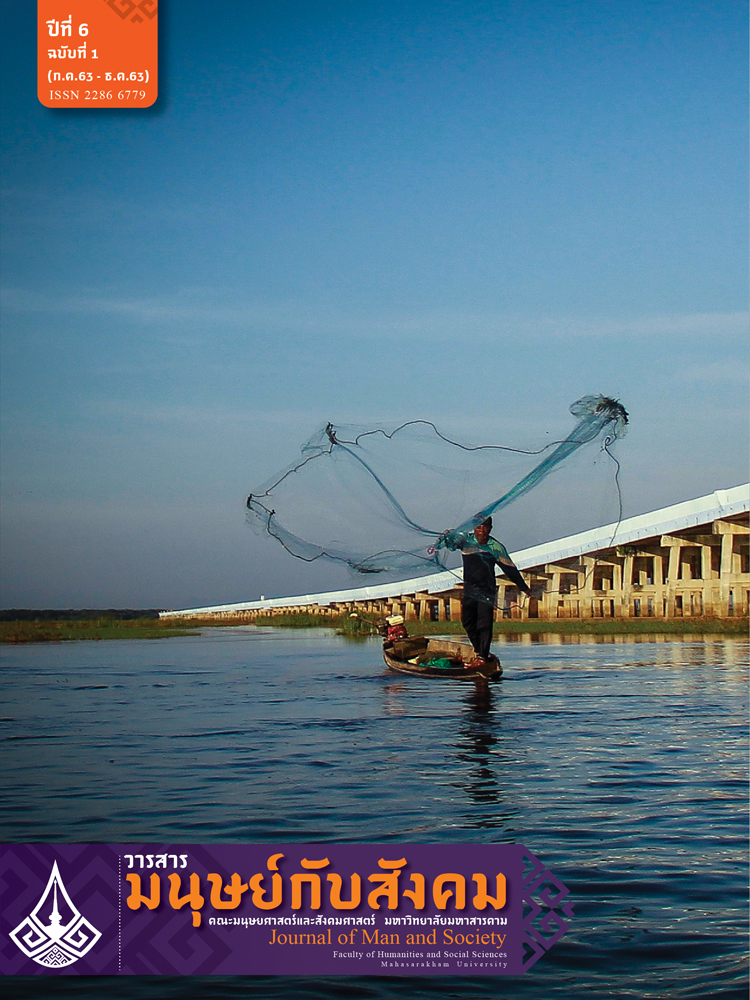Adapting to Climate Change through Migration and Vulnerability of the Khmer Ethnic Group in the Mekong Delta of Viet Nam
Main Article Content
Abstract
This article discusses the relationship between climate change and internal migration. It also discusses the vulnerability of the Khmer ethnic group in Viet Nam. In particular, the article focuses on the Khmer residing in a small village of the Mekong Delta, an area deemed to be one of the world’s climate hotspots. Through a study of the villagers’ everyday lives experiences, the article examines how climate change, as one of the key drivers causing regional migration, directly and indirectly, affects villagers’ out-migration decision-making. The study demonstrates that migration is used as an adaptation strategy to cope with the stresses caused by climate change. Additionally, climate change impacts pose greater challenges to the Khmer, whose ethnic minority status makes them more vulnerable than Viet Nam’s ethnic majority. To cope with climate change impacts, the Khmer have utilized migration as a form of risk management in their decision-making. This article identifies the underlying mechanisms that increase the Khmer’s vulnerability and make it difficult to remain in risk areas. These mechanisms include stigmatization and exclusion, illiteracy, and indebtedness. There are, moreover, reproduction mechanisms to keep the Khmer in a vicious cycle of vulnerability, such as elevated early education dropout rates, harmful migration policies, and loan injections. These mechanisms affect the Khmer’s migration patterns to cope with climate change and impact the Khmer’s ability to successfully adapt to the sending place.
Article Details
เนื้อหาและข้อมูลที่ตีพิมพ์ลงในวารสารมนุษย์กับสังคม ถือเป็นข้อคิดเห็นและความรับผิดชอบโดยตรงของผู้เขียนซึ่งกองบรรณาธิการวารสารไม่จำเป็นต้องเห็นด้วยหรือร่วมรับผิดชอบใดๆ
บทความ ข้อมูล เนื้อหา รูปภาพ ฯลฯ ที่ได้รับการตีพิมพ์ในวารสารมนุษย์กับสังคม ถือเป็นลิขสิทธิ์ของวารสาร หากบุคคลหรือหน่วยงานใดต้องการนำทั้งหมดหรือส่วนหนึ่งส่วนใดไปเผยแพร่ต่อต้องอ้างอิงวาสาร
References
กฤษดา ปัจจ่าเนย์ และธนพฤกษ์ ชามะรัตน์. (2561). “ผลกระทบจากการกลายเป็นเมืองด้านการเข้าถึงและครอบครองสินทรัพย์ทุนของครัวเรือนแรงงานชานเมืองขอนแก่น”, วารสารราชภัฏสุราษฎร์ธานี, 5 (2), 101-126.
กาญจนา เค้าปัญญา, บัวพันธ์ พรหมพักพิง และฟ้ารุ่ง มีอุดร. (2554). “แรงงานอพยพพม่าในจังหวัดอีสานนครของภาคอีสาน”, วารสารวิจัย มข. (ฉบับบัณฑิตศึกษา), 11(4), 123-134.
กฤตยา อาชาวนิจกุล. (2545). สถานะความรู้เรื่องแรงงานข้ามชาติในประเทศไทยและทิศทางการวิจัยที่พึงพิจารณา. นครปฐม: สถาบันวิจัยประชากรและสังคม มหาวิทยาลัยมหิดล.
จรัมพร โห้ลำยอง และสุรีย์พร พันพึ่ง. (2559). “แรงงานต่างด้าวในประเทศไทย: สิ่งที่คนไทยต้องรู้” ในพัทยา เรือนแก้ว, สุภางค์ จันทวานิช และฉันทนา บรรพศิริโชติ หวันแก้ว (บรรณาธิการ). ไทยต่างด้าว ท้าวต่างแดน: สังคมวิทยาของชีวิตข้ามพรมแดน. กรุงเทพฯ: สำนักพิมพ์แห่งจุฬาลงกรณ์มหาวิทยาลัย.
จันทะลา วรรณหงส์ และธนพฤกษ์ ชามะรัตน์. (2559). “ปัจจัยการย้ายถิ่นของแรงงานสตรีลาวในจังหวัดอุดรธานี”, วารสารมนุษย์กับสังคม คณะมนุษยศาสตร์และสังคมศาสตร์มหาวิทยาลัยมหาสารคาม, 1(2), 145-158.
ธนพฤกษ์ ชามะรัตน์. (2559). “บอดใบ้ในไหปลาแดก : การรับรู้ผลกระทบจากข้อตกลงยอมรับร่วมด้านคุณสมบัติวิชาชีพการท่องเที่ยวอาเซียนของแรงงานอีสาน”, วารสารคณะมนุษยศาสตร์และสังคมศาสตร์ มหาวิทยาลัยขอนแก่น, 33(3),193-221.
ปิยวรรณ เปี่ยมคล้า. (2558). ปัจจัยกำหนดการย้ายถิ่นกลับภูมิลำเนาของแรงงานต่างด้าวสัญชาติเมียนมา ผลกระทบต่อผู้ประกอบการและกลยุทธ์การรับมือ กรณีศึกษาจังหวัดกาญจนบุรี. วิทยานิพนธ์ปริญญาเศรษฐศาสตรมหาบัณทิต สาขาวิชาเศรษฐศาสตร์ธุรกิจ มหาวิทยาลัยธรรมศาสตร์.
พัชราวลัย วงศ์บุญสิน. (2552). การย้ายถิ่น: ทฤษฎีและความเป็นไปได้ในเอเชีย. กรุงเทพฯ: วิทยาลัยประชากรศาสตร์.
ภคริดา พิจารณ์ และจงรักษ์ หงส์งาม. (2559). “ปัจจัยที่ส่งผลต่อการตัดสินใจย้ายถิ่นของแรงงานต่างด้าว : กรณีศึกษาจังหวัดขอนแก่น ประเทศไทย”, วารสารวิทยาลัยบัณฑิตศึกษาการจัดการ มหาวิทยาลัยขอนแก่น, 9(1),49 - 63.
วิกานดา ตั้งเตรียมใจ, สุขุมวิทย์ ไสยโสภณ และกฤษฎา ณ หนองคาย. (2562). “ปัจจัยที่มีผลต่อการตัดสินใจเข้ามาทำงานของแรงงานข้ามชาติในประเทศไทย”, วารสารรามคำแหง ฉบับบัณฑิตวิทยาลัย, 2(3),47 - 58.
วิลาสิณี คีตวัฒนานนท์, Natthani Meemon, Seung Chun Paek, ธรรมรัตน์ มะโรหบุตร. (2559). “ความเจ็บป่วยและการแสวงหาการดูแลสุขภาพของแรงงานข้ามชาติกัมพูชาที่ตลาดการค้าชายแดนช่องจอมจังหวัดสุรินทร์”, วารสารวิจัยและพัฒนา มหาวิทยาลัยราชภัฏสวนสุนันทา, 8 (2), 92-105.
สุภางค์ จันทวานิช. (2540). การย้ายถิ่นข้ามชาติในภูมิภาคเอเชีย-แปซิฟิก : ปัญหาและแนวโน้ม. กรุงเทพฯ: สถาบันเอเชียศึกษา จุฬาลงกรณ์มหาวิทยาลัย.
สุภางค์ จันทวานิช. (2545). ตลาดแรงงานไทยในเอเชียและเอเชียตะวันออกเฉียงใต้: ผลกระทบจากภาวะเศรษฐกิจถดถอยในปลายทศวรรษ 90. (รายงานการวิจัย). กรุงเทพฯ: ศูนย์วิจัยการย้ายถิ่นแห่งเอเชีย สถาบันเอเชียศึกษา จุฬาลงกรณ์มหาวิทยาลัย.
สำนักบริหารแรงงานต่างด้าว. (2562). สถิติจำนวนคนต่างด้าวที่ได้รับอนุญาตทำงานคงเหลือทั่วราชอาณาจักร ประจำเดือนกันยายน 2562. [Online]. เข้าถึงเมื่อ 18 มีนาคม 2563, สืบค้นจาก https://www.doe.go.th/alien.
องค์การระหว่างประเทศเพื่อการโยกย้ายถิ่นฐาน. (2556). โครงการศึกษาการเปลี่ยนแปลงรูปแบบการย้ายถิ่นของแรงงานเมียนมาและผลกระทบต่อประเทศไทย. กรุงเทพฯ: องค์การระหว่างประเทศเพื่อการโยกย้ายถิ่นฐาน สำนักงานกรุงเทพฯ.
Chamaratana, Thanapauge and Sangseema, Thawatchai. (2018). “Moving on the Chain: Push-Pull Factors Affecting the Migration of Laotian Workers to Udon Thani, Thailand”, European Journal of Social Sciences Education and Research. Volume 5( 2),109-115.
Chamaratana, Thanapauge; Ayuwat, Dusadee; Knippenberg, Luuk and De Jong, Edwin. (2010). “Connecting the Disconnected: Background, practices and motives of labour brokers in Isan, Thailand - an explorative study”, The International Journal of Interdisciplinary Social Sciences, 5 (5), 359-372.
Goss, John. and Lindquist, Brian. (1995). Conceptualizing International Labor Migration: A Structuration Perspective. International Migration Review, 29(2), 317 – 351.
Hugo, Graeme. (2004). “International Migration in Southeast Asia since Word War II” in Ananta, Aris and Arifin, Evi N. (Editors). International Migration in Southeast Asia. Singapore: ISEAS Publishing.
Hugo, Graeme and Young, Soogil. (2008). Labour Mobility in the Asia-Pacific Region. Singapore: ISEAS Publishing.
Lee, Everett S. (1966). A Theory of Migration. Demography, 3(1), 9-15.
Moses, Jonathon, W. (2006). International Migration: Globalization’s Last Frontier. London: Zed Books.
Neuman, William. L. (2004). Basic of Social Research: Qualitative and Quantitative Approaches. Boston: Pearson Education.
Pearson, Ruth and Kusakabe, Kyoko. (2013). Thailand’s Hidden Workforce: Burmese Migrant Women Factory Workers. Bangkok: OS. Printing House.
Schaefer, Richard. (2003). Sociology, 8th ed. New York: McGraw-Hill.
Yamane, Taro. (1973). Statistics: An Introduction Analysis. 3rd ed. New York: Harper and Row Publisher, Inc.


